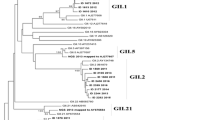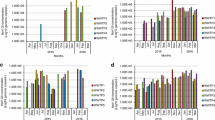Abstract
Noroviruses (NoVs) give rise to clinically relevant gastroenteritis in all age groups and are widely distributed in both clinical and environmental settings. NoVs are classified into five genogroups (GI to GV), of which GI, GII and GIV infect humans. While data on the epidemiology of human NoVs GI and GII have been steadily increasing, very little information has been published on the spread of GIV in either the health care system or the environment, resulting in a lack of information about its clinical significance and pathogenesis. In order to investigate the distribution of GIV strains in the environment, we analyzed sewage samples collected from five treatment plants, by using newly designed nested RT-PCR assays. A collection of clinical stool samples, originating from pediatric patients with symptoms of acute gastroenteritis, previously analyzed in our laboratory for the presence of NoV GI or GII, was also analyzed for the presence of GIV norovirus. Results of this work attest to the presence of GIV in both clinical and environmental contexts and underline the importance of routinely screening for this genogroup, along with GI and GII, in order to better understand its distribution, prevalence and role during epidemics, which is probably underestimated.


Similar content being viewed by others
References
Blanton LH, Adams SM, Beard RS, Wei G, Bulens SN, Widdowson MA, Glass RI, Monroe SS (2006) Molecular and epidemiologic trends of caliciviruses associated with outbreaks of acute gastroenteritis in the United States, 2000–2004. J Infect Dis 193:413–421
Atmar RL, Estes MK (2006) The epidemiologic and clinical importance of norovirus infection. Gastroenterol Clin North Am 35:275–290
Fankhauser RL, Monroe SS, Noel JS, Humphrey CD, Bresee JS, Parashar UD, Ando T, Glass RI (2002) Epidemiologic and molecular trends of “Norwalk-like viruses” associated with outbreaks of gastroenteritis in the United States. J Infect Dis 186:1–7
Koopmans M, Duizer E (2004) Foodborne viruses: an emerging problem. Int J Food Microbiol 90:23–41
La Rosa G, Pourshaban M, Iaconelli M, Muscillo M (2008) Recreational and drinking waters as a source of norovirus gastroenteritis outbreaks: a review and update. Environ Biotechnol 4(1):15–24
Zheng DP, Ando T, Fankhauser RL, Beard RS, Glass RI, Monroe SS (2006) Norovirus classification and proposed strain nomenclature. Virology 346:312–323
Bertolotti-Ciarlet A, Crawford SE, Hutson AM, Estes MK (2003) The 3′ end of Norwalk virus mRNA contains determinants that regulate the expression and stability of the viral capsid protein VP1: a novel function for the VP2 protein. J Virol 77:11603–11615
La Rosa G, Fontana S, Di Grazia A, Iaconelli M, Pourshaban M, Muscillo M (2007) Molecular identification and genetic analysis of norovirus genogroups I and II in water environments: comparative analysis of different reverse transcription-PCR assays. Appl Environ Microbiol 73: 4152–4161. Erratum in: Appl Environ Microbiol (2007); 73(19):6329
Wolf S, Williamson WM, Hewitt J, Rivera-Aban M, Lin S, Ball A, Scholes P, Greening GE (2007) A sensitive multiplex real-time RT-PCR assay for the detection of human and animal noroviruses in clinical and environmental samples. Appl Environ Microbiol 73:5464–5470
Dreier J, Stormer M, Made D, Burkhardt S, Kleesiek K (2006) Enhanced reverse transcription-PCR assay for detection of norovirus genogroup I. J Clin Microbiol 44:2714–2720
Le Guyader FS, Bon F, DeMedici D, Parnaudeau S, Bertone A, Crudeli S, Doyle A, Zidane M, Suffredini E, Kohli E, Maddalo F, Monini M, Gallay A, Pommepuy M, Pothier P, Ruggeri FM (2006) Detection of multiple noroviruses associated with an international gastroenteritis outbreak linked to oyster consumption. J Clin Microbiol 44:3878–3882
Medici MC, Martinelli M, Ruggeri FM, Abelli LA, Bosco S, Arcangeletti MC, Pinardi F, De Conto F, Calderaro A, Chezzi C, Dettori G (2005) Broadly reactive nested reverse transcription-PCR using an internal RNA standard control for detection of noroviruses in stool samples. J Clin Microbiol 43:3772–3778
Kroneman A, Vennema H, Harris J, Reuter G, von Bonsdorff CH, Hedlund KO, Vainio K, Jackson V, Pothier P, Koch J, Schreier E, Bottiger BE, Koopmans M (2006) Increase in norovirus activity reported in Europe. Euro Surveill 11:E061214
Martella V, Campolo M, Lorusso E, Cavicchio P, Camero M, Bellacicco AL, Decaro N, Elia G, Greco G, Corrente M, Desario C, Arista S, Banyai K, Koopmans M, Buonavoglia C (2007) Norovirus in captive lion cub (Panthera leo). Emerg Infect Dis 13:1071–1073
Martella V, Lorusso E, Decaro N, Elia G, Radogna A, D’Abramo M, Desario C, Cavalli A, Corrente M, Camero M, Germinario CA, Banyai K, Di Martino B, Marsilio F, Carmichael LE, Buonavoglia C (2008) Detection and molecular characterization of a canine norovirus. Emerg Infect Dis 14:1306–1308
Vinje J, Koopmans MP (2000) Simultaneous detection and genotyping of “Norwalk-like viruses” by oligonucleotide array in a reverse line blot hybridization format. J Clin Microbiol 38:2595–2601
Lindell AT, Grillner L, Svensson L, Wirgart BZ (2005) Molecular epidemiology of norovirus infections in Stockholm, Sweden, during the years 2000 to 2003: association of the GGIIb genetic cluster with infection in children. J Clin Microbiol 43:1086–1092
Iritani N, Seto Y, Kubo H, Haruki K, Ayata M, Ogura H (2002) Prevalence of “Norwalk-like virus” infections in outbreaks of acute nonbacterial gastroenteritis observed during the 1999–2000 season in Osaka City, Japan. J Med Virol 66:131–138
Scotto-Lavino E, Du G, Frohman MA (2006) 5′ End cDNA amplification using classic RACE. Nat Protoc 1:2555–2562
Phan TG, Kaneshi K, Ueda Y, Nakaya S, Nishimura S, Yamamoto A, Sugita K, Takanashi S, Okitsu S, Ushijima H (2007) Genetic heterogeneity, evolution, and recombination in noroviruses. J Med Virol 79:1388–1400
Waters A, Coughlan S, Hall WW (2007) Characterisation of a novel recombination event in the norovirus polymerase gene. Virology 363:11–14
Bull RA, Tu ET, McIver CJ, Rawlinson WD, White PA (2006) Emergence of a new norovirus genotype II.4 Variant associated with global outbreaks of gastroenteritis. J Clin Microbiol 44:327–333
Van den Berg H, Lodder W, van der Poel W, Vennema H, Roda Husman AM (2005) Genetic diversity of noroviruses in raw and treated sewage water. Res Microbiol 156:532–540
Acknowledgments
This study was partly funded by the project “Rapid diagnosis of viruses in sewage” (CCM n.4393, ISS Prot. 8M09) of the Italian Center for Disease Control and Prevention (CCM—Centro nazionale per la prevenzione e il controllo delle malattie) and the Italian Ministry of Labour, Health and Social Policy. We are grateful to C. Moretti, F. Midulla, and M. Battaglia of the Policlinico Umberto I of Rome for providing clinical samples.
Author information
Authors and Affiliations
Corresponding author
Rights and permissions
About this article
Cite this article
La Rosa, G., Pourshaban, M., Iaconelli, M. et al. Detection of genogroup IV noroviruses in environmental and clinical samples and partial sequencing through rapid amplification of cDNA ends. Arch Virol 153, 2077–2083 (2008). https://doi.org/10.1007/s00705-008-0241-4
Received:
Accepted:
Published:
Issue Date:
DOI: https://doi.org/10.1007/s00705-008-0241-4




